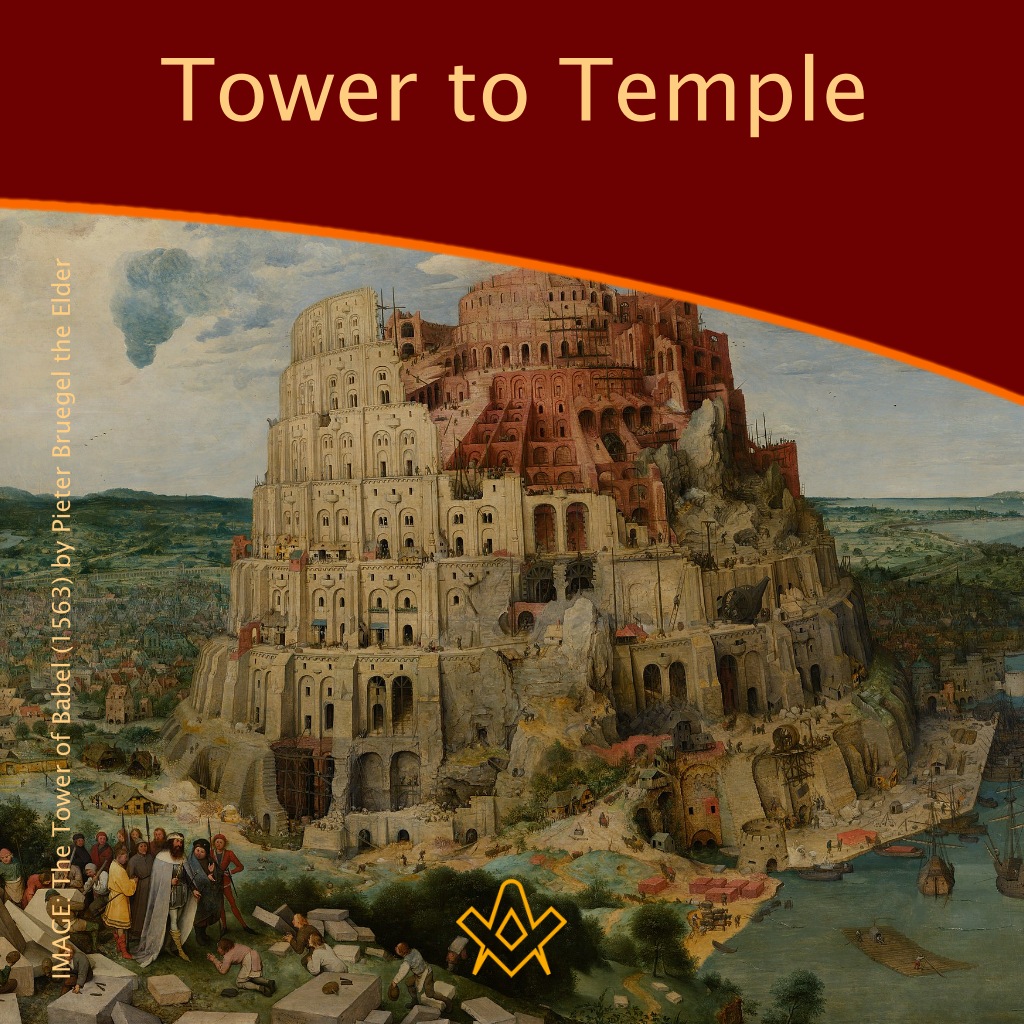From Tower to Temple: From Babble to Knowing ?
For at the Building of the Tower of Babel, the Art and Mystery of Masonry was first introduc’d, and from thence handed down by Euclid, a worthy and excellent Mathematician of the Egyptian, and he communicated it to Hiram, the Master-Mason concern’d in the Building of Solomon’s Temple in Jerusalem.
Source: – (Samuel Pritchard, Masonry Dissected, 1738)
When publishing Masonry Dissected, it was not Prichard’s intention to flatter Freemasonry; perhaps this was indicated with his assignment of its operative origin to the construction of the Tower of Babel! Twice in his Constitutions, Anderson refers to:
..the confusion at Babel …the Sciences and Arts were both transmitted to later ages and distant climes notwithstanding the confusion of languages or dialects which tho’ give help to rise the masonic faculty and ancient universal practice of conversing without speaking and knowing each other at a distance.
How are we to make sense of the VSL’s account of the Tower of Babel? Perhaps we are entitled to some preliminary confusion as prior to its construction, the families descending from Noah were, after their tongues.
Yet, this is immediately followed by, ‘And the whole earth was of one language and of one speech.’
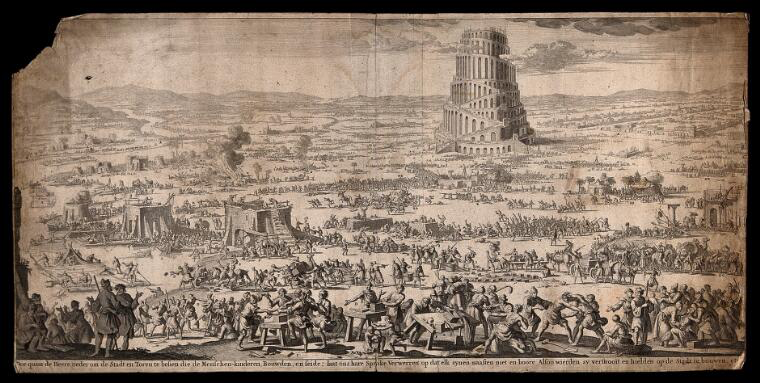
An extremely detailed survey of the activities surrounding the building of the tower of Babel. Engraving, c. 1680.
IMAGE LINKED: wellcome collection Attribution 4.0 International (CC BY 4.0)
The Canaanites, of the line of Noah, Ham and Cush, chose in the land of Shinar a plain on which to build a city with a tower whose top reached to heaven.
Was Pritchard familiar with Genesis 11 which quotes them saying to one another, ‘let us make brick, and burn them thoroughly….they had brick for stone and slime for mortar’.
No self-respecting operative freemason would be involved in such an undertaking and reject any assertion that it was from Babel that Freemasonry took its rise; indeed, to suggest such is taking the rise out of Freemasonry!
Returning to the Genesis narrative, this oneness of language led to unrestrained imagination. Thus through extra-terrestrial intervention, language was confounded, the people were scattered and the construction remained unfinished.
That is to say, Heaven and Earth did not meet at Babel.
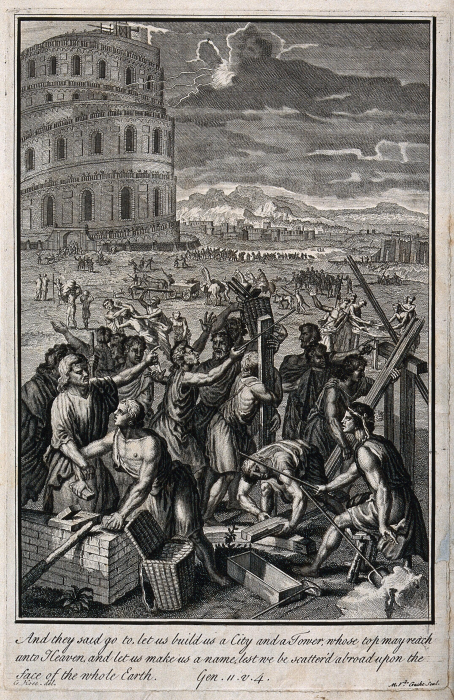
The builders of the Tower of Babel start to argue as their language is confounded. Etching by M. van der Gucht after G. Hoet, c. 1700.
IMAGE LINKED: wellcome collection Attribution 4.0 International (CC BY 4.0)
How are we to understand this “confounding of language” and better, to mitigate its confusion? For Freemasons, Anderson indicates, shared signs and tokens.
Post-Babel, might there remains a measure of confusion within language? Delightful though it often is, we cannot really claim to derive meaning from the sound, made by babies, and designated ‘babbling’ (from ‘Babel’.)
Whatever we may think and feel, babbling from the mouths of “babes and sucklings” cannot provide propositions which either are the case – or are not the case – even with unrestrained imagination.
If a proposition can neither be the case – nor not be the case – clarity is not to be found. Rather, confounding; through being scattered abroad upon the face of the Earth, we are seeking clear communication.
The Freemason’s task is to consider all propositions and subject them to a test of coherence. (Perhaps this would explain why religion and politics are not to be discussed within the lodge!)
With that, we must head for the Temple. The allegorical significance of King Solomon’s Temple is something uniting Freemasons even though, scattered abroad upon the face of the earth and able to understand the speech of only some grand lodges.
A main purpose for building the Temple was to provide a worthy location for the Ark of the Covenant at which place the extent of things – over-all – could be considered by an individual.
A place where heaven and earth might meet: a place where the imagination could be unrestrained.
On the other hand, a temple was an administrative centre, a place where God and the mammon of unrighteousness met – money changers et alia! Perhaps it was on Arunah’s threshing floor in Jerusalem the site where “temples”, Jewish, Christian and Islamic converge, combine, coagulate, compete, challenge and confront!
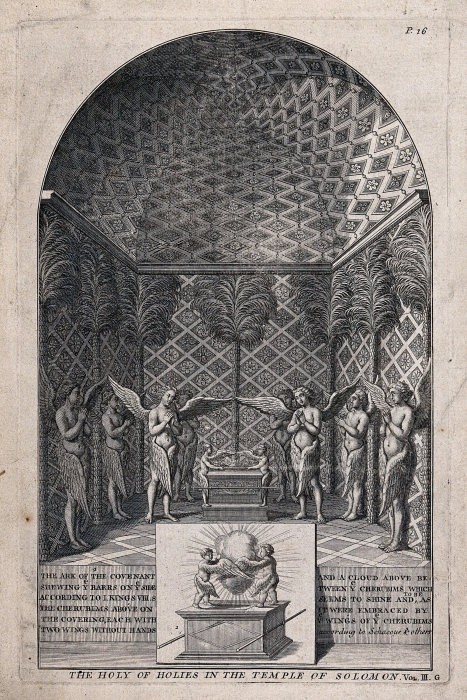
The ark of the covenant guarded by angels in the Temple of Solomon. Engraving.
IMAGE LINKED: wellcome collection Attribution 4.0 International (CC BY 4.0)
Without a doubt, the urge to build bigger and better has been an incredible incentive. Where a deity has been the fiction to maintain a polity, it has been the practice to build an edifice over-powering and subsuming all looking thereon: perhaps Abu Simbel an exemplar.
Yet, when an edifice was constructed on the purported site of an ascension it invited crusades and cathedral building: the former a tragedy, the latter over-powering.
Both activities combine well to provide the romantic fiction underpinning some aspects of contemporary Freemasonry.
There is no problem with that – an essential strand of the European Enlightenment was indeed romantic – perhaps the troubadour’s legacy found in Goethe and Wagner.
However, perhaps it would be helpful to return to basics and consider Acts 7:
![]()
Solomon built him a house.
Howbeit the most High dwelleth
not in temples made with hands
The original disciples “broke bread from house to house eating their meat with gladness and singleness of heart”.
The festive board does not have to be a million miles away from this. Sharing a meal is a serious human activity and from this association and sociability can flow a reinforcement of moral determination and decisiveness.
Where should such a meal be celebrated; what might be the import of, “The Most High dwelleth not in temples made with hands”? Oh dear: has there been labour in vain?
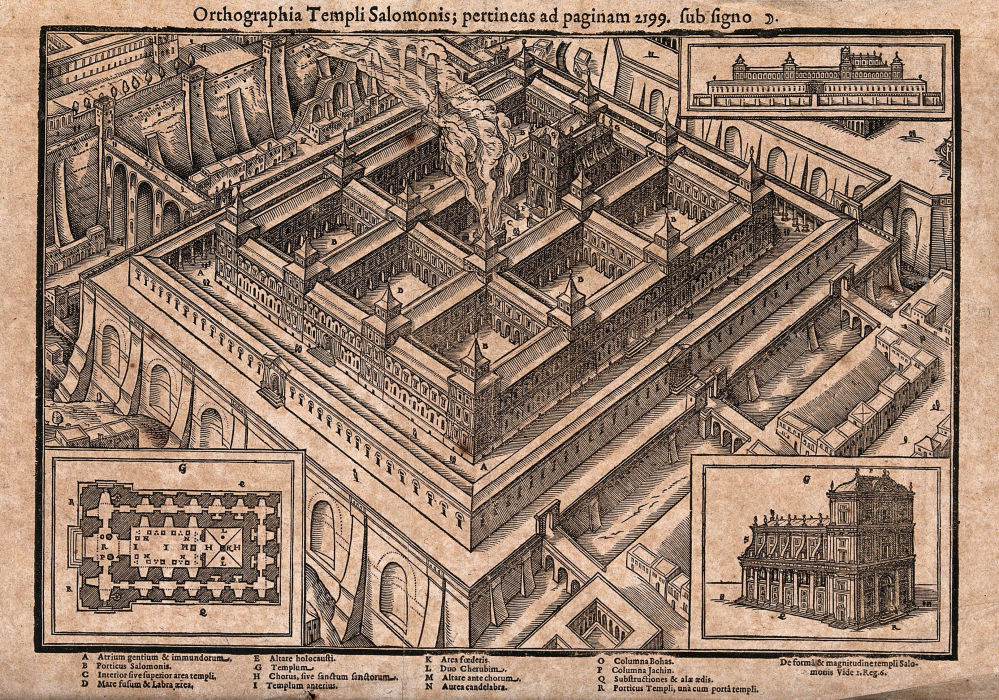
The Temple of Solomon: aerial view, with flames billowing from the sacrificial altar. Wood engraving.
IMAGE LINKED: wellcome collection Attribution 4.0 International (CC BY 4.0)
No, Temples were constructed as a statement of command and control to achieve compliance and conformity; so big, dwarfing anything around.
Perhaps the view could be taken that behaviours within temples are exaggerated and do not always concur with behaviours outside; yet, it is the behaviours outside which provide the test.
The temple experience is perhaps an ideal and unattainable. If the Most High does not dwell in temples made with hands where does this leave Freemasons?
As persons we are temples not made with hands and with us ‘dwells’ the potential for worthiness. Yes, daily Masonic improvement advances us for the purpose of advancing all those with whom we engage.
That is to say, we are what we do: but what are we? Perhaps the world is all that is the case; that our world is our language and the limits of our world are the limits of our language.
In Acts Chapter 2 we read of Pentecost and devout men of every nation under heaven; yet, every man heard them speak in his own language.
Ah, here is the mitigation of Babel! Not in a temple but in a public place: Freemasonry must be demonstrated where we are.
Language can be a divide. Not confusion among languages but rather within language, a seriously unclear understanding of another’s world-view.
We assume it is so different from our own and yet with clarity, a realisation there is more which unites than separates.
How and why does that mote of difference over-power the plank of convergence.
Diversity must be understood as a power enabling Freemasons to understand and respect differing world-views; thereby avoiding institutional disrespect and as thus enabled, bridge-building on the foundations of shared values: no longer remaining apart.
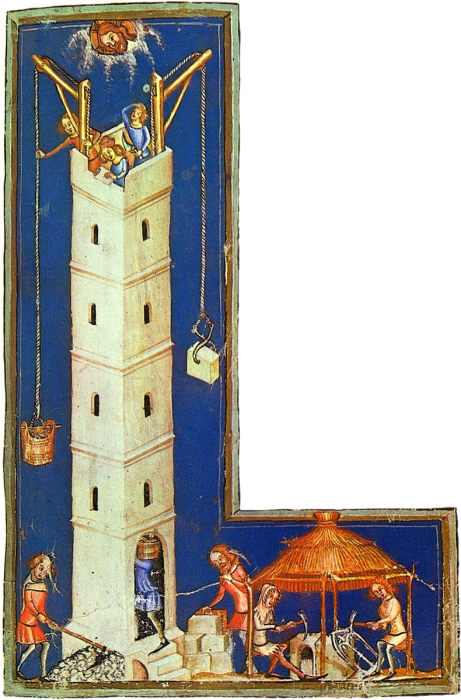
German Late Medieval (c. 1370s) depiction of the tower’s construction. Meister der Weltenchronik, c.1370
IMAGE LINKED: wikimedia Attribution 4.0 International (CC BY 4.0)
Originally published in CANDIDE’S COLUMN, Winter 2008
![]()
If this is the best of all possible worlds,
what are the others ?
– Voltaire, Candide
Did you know ?
The phrase “Tower of Babel” does not appear in the Bible; it is always “the city and the tower” (אֶת-הָעִיר וְאֶת-הַמִּגְדָּל) or just “the city” (הָעִיר).
The original derivation of the name Babel (also the Hebrew name for Babylon) is uncertain. The native, Akkadian name of the city was Bāb-ilim, meaning “gate of God”.
However, that form and interpretation itself are now usually thought to be the result of an Akkadian folk etymology applied to an earlier form of the name, Babilla, of unknown meaning and probably non-Semitic origin.
According to the Bible, the city received the name “Babel” from the Hebrew verb בָּלַל (bālal), meaning to jumble or to confuse.
Source: Wikipedia
Article by: Gerald Reilly

Gerald Reilly was initiated in 1995 into St Osyth's Priory Lodge 2063. Essex. England (UGLE).
He was a founder member of Josh Heller's Allthingsmasonic, and with Josh co-wrote 'The Temple that Never Sleeps' (Cornerstone Books, 2006) he is committed to the development of e-Freemasonry.
Awarded the Norman B Spencer Prize, 2016.
Book: by Gerald Reilly

The Temple That Never Sleeps
by Josh Heller and Gerald Reilly
Freemasons and E-Masonry Toward a New Paradigm
A revolutionary book for every Freemason.The two authors, American and UK Masons, present a radical view of Freemasonry for both today and tomorrow.
In addition to their ideas are those of numerous Internet Masons (E-Masons) from around the world who, by sharing the experience of their own Masonic journey, have provided stunning personal insight into the viability of the Craft in the Internet Age.
This book will challenge your understanding of Freemasonry today and how it might transform for future generations.
Recent Articles: by Gerald Reilly
 How can the allegory of the Tower of Babel teach us tolerance? Language can be a divide. Not confusion among languages but rather within language, a seriously unclear understanding of another’s world-view. We assume it is so different from our own and yet with clarity, a realisation there is more which unites than separates. |
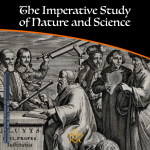 The Imperative Study of Nature and Science At some stage during Freemasonry's Second Degree, the candidate is advised that there is now permitted, something like, the extension of their research into the hidden mysteries of nature and science. Such is an excellent permission and one that each and every Freemason should pursue with awe and passion. |
 Pure Ancient Masonry; P4. A Companion in Rule, Building a better world P4. A Companion in Rule, Building a better world - The four parts of Pure Antient Masonry comprise the ‘body’ Masonic; they are the building blocks of the vital relevance, through enhanced citizenship, wherein the soul of Freemasonry abides. |
 Pure Ancient Masonry; P3. The Master, Building Better Character Part 3: The Master, Building Better Character - Being raised is a transition from knowledge to wisdom. |
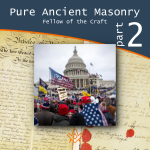 Pure Ancient Masonry; P2. A Fellow of the Craft Part 2: A Fellow of the Craft, Building Better Knowledge. Pure Antient Masonry consists of four parts. ‘Building the Temple’ is the fundamental Masonic allegory for building better people; this must be understood as a seamless whole: |
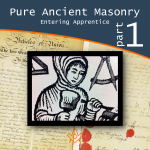 Pure Ancient Masonry; P1. An Entering Apprentice Part 1. An entering apprentice: Building Better Communities; Pure Antient Masonry consists of four parts. ‘Building the Temple’ is the fundamental Masonic allegory for building better people to build a better world |
 Pure Ancient Masonry; Intrduction This series will consider the defining characteristics, lessons and benefits of Three Degrees, the Order of the Royal Arch and when conjoined, Pure Ancient Masonry. |
 The Christianising of British Freemasonries - P4 This concluding article in the series considers the separation of British freemasonries from the Grand Orient of France (GOdF) and maintaining fraternity with the Prussian Grand Lodge of the Three Globes. |
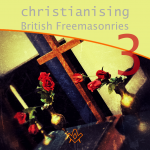 The Christianising of British Freemasonries - P3 Discover the battle for the 'soul' of Masonry. Part 3. French Perdition: ‘…for what fellowship hath righteousness with unrighteousness’? |
 The Royal Arch – ‘the fourth step in regular Freemasonry’ United Grand Lodge of England, has now designated the Royal Arch, the fourth step in regular Freemasonry, it therefore must be concluded that…publications…should now be revised, and based on attracting to the benefits of the four steps. |
 The Christianising of British Freemasonries - P2 How might the battle for the souls of Freemasonries be identified in a way that ensures thriving in the 21st Century? There is no guarantee of the immortality of the soul of Freemasonry! ‘We study the past in order to free ourselves from it.’ (Hariri) |
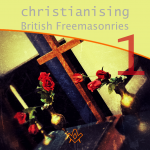 The Christianising of British Freemasonries - P1 This four-part series considers: 1. the separation of British Freemasonries from the Grand Orient of France (GOdF); and, 2. maintaining fraternity with the Prussian Grand Lodge of the Three Globes. |
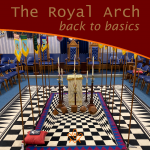 The Royal Arch - Back to Basics In the Royal Arch ceremony, the sojourners are buried with their tools in a vault. The sun, at its highest, provides enlightenment and the principal sojourner is returned to the former companions of his toil |
 The Holy Land and the Holy Sites P4 Fourth instalment of the four-part series, considers ‘masonic’ aspiration and activity regarding the Holy Land and The Holy Sites |
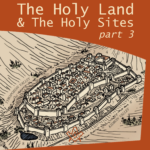 The Holy Land and The Holy Sites P3 Third instalment of the four-part series, considers ‘masonic’ aspiration and activity regarding the Holy Land and The Holy Sites |
 The Holy Land and The Holy Sites P2 The four-part series will consider ‘masonic’ aspiration and activity regarding the Holy Land and The Holy Sites |
 The Holy Land and The Holy Sites P1 In this four-part series, we will consider ‘masonic’ aspiration and activity regarding the Holy Land and The Holy Sites |
 Science and Citizenship: Towards a 21st Century Masonic Mindset. |
 Towards a 21st Century Masonic Mindset: Part 3 ‘Freemasonries’ and the Fourth Industrial Revolution |
 Towards a 21st Century Masonic Mindset: Part 2: ‘Freemasonries’ and Religiosity. |
 Towards a 21st Century Masonic Mindset: Part 1: ‘Freemasonries’ and Governance. |
masonic knowledge
to be a better citizen of the world
share the square with two brothers

click image to open email app on mobile device


